
‘Change is good’: Residents see jobs, future for Fostoria through Trump
9/9/2018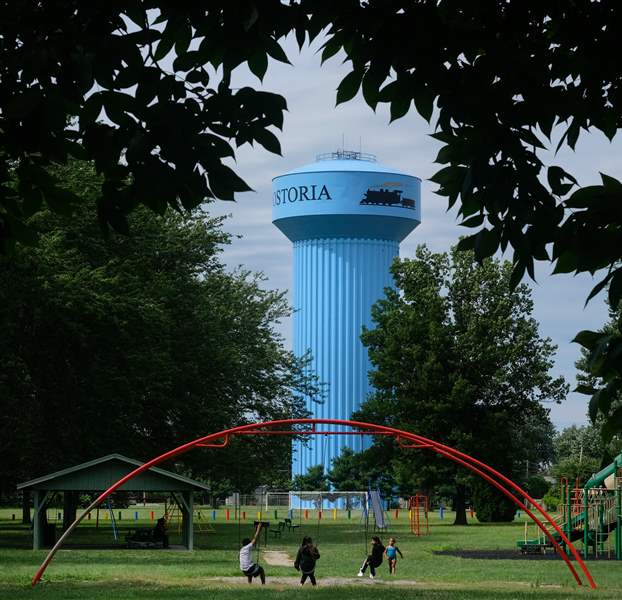
From left: Bryan Stenson, 17, Cassandra Hinojosa, 16, Myliana Bernal, 11, and Gianna Yarbrough, 4, play at Jackson Street Park in Fostoria.
THE BLADE/JEREMY WADSWORTH
Buy This Image
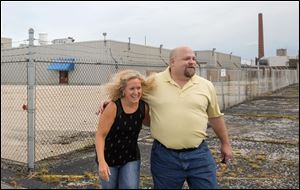
Former Autolite employees Tracy Courtney and Chris Mathias outside the old plant Friday, July 20, 2018, in Fostoria.
Second in a five-part series
Tracy Courtney always thought Fostoria’s Honeywell Autolite factory would be the first and last place she would ever work.
She came to Autolite at 18. It was August, 1992, and she had graduated from high school just two months before. She was starting work as a production checker, a good union job. Her pay was a solid $11.30 an hour, insurance was covered, and there was a 30-and-out retirement program — all she had to do was keep working until she hit 48.
The promise of early retirement was what kept Mrs. Courtney, 44, at Autolite, despite repeated cuts, a shrinking production line, and tough, dirty work.
“I’m like, I get my 30 years and I’ll be 48 and be able to retire,” she said. “Well, that didn’t quite happen.”
Blade Series: Views from small-town Ohio

Former Autolite employees Tracy Courtney and Chris Mathias outside the old plant Friday, July 20, 2018, in Fostoria.
Once, Autolite was Fostoria’s largest employer, with more than 1,000 employees. But in the last few decades the plant shrunk to a fraction of its former size, notably sending many of its jobs to Mexico in the wake of NAFTA in 2008.
The nail in the coffin came in October, 2017, when the company announced to its 54 remaining union employees that the Fostoria plant was closing its doors for good.
Mrs. Courtney was one of 10 employees who stayed on to clean up the shuttered factory, and one of four to stick it out until their contracts officially ended on the last day in May.
She’s back on the job market now, the thought of retiring at 48 reduced to fantasy. Though she lives just outside of Fostoria in Arcadia, she’ll probably work in Findlay — job options are better there.
“Fostoria is like a ghost town now,” she said on an evening in July.
To get through the challenging transition, she’s reminded herself time and again: “Change is good.” The same mantra inspired her vote for Donald Trump in the 2016 presidential election.
The story of the Autolite plant is, in many ways, the story of Fostoria. Once booming and flushed with possibility, these days downtown is quiet, storefronts are empty, and money is tight.
Regardless of political leanings or party affiliation, the more than 50 people The Blade spoke with all agreed on one thing: The city needs jobs. There are those who say that the possibility of redemption is distant at best and impossible at worst. But others are hopeful that Fostoria can return to a version of its former self.
Some think Mr. Trump is the reason why.
‘A different time’
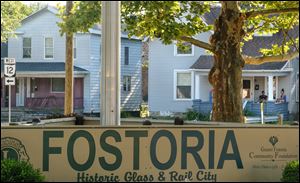
Regardless of political leanings or party affiliation, the more than 50 people The Blade spoke with all agreed on one thing: The city needs jobs.
If you look at Fostoria on a map, you’ll see a meeting place. The town sits squarely where Hancock, Seneca, and Wood counties abut one another. And three major railroad lines run through its center, intersecting to form what’s called the “Iron Triangle.” Around 100 trains rumble across these tracks each day.
In days gone by, five railroad companies served Fostoria, including four of the five major systems in Ohio: the New York Central, the Baltimore & Ohio, the Chesapeake & Ohio, and the New York, Chicago & St. Louis — the latter also known as the Nickel Plate Road.
The fifth, the Lake Erie & Western, would become part of Nickel Plate, and in later years mergers and abandonments winnowed the field to the modern-day CSX Transportation and Norfolk Southern.
Fostoria’s web of rail carried people, mail, parcels, and industrial cargoes between Fostoria and points in all directions near and far, including Columbus, St. Louis, Chicago, Toledo, Detroit, Sandusky, Cleveland, and Pittsburgh.
This rail access was a main reason why Fostoria became a hot spot for manufacturing in the 19th and 20th centuries. Glassmakers in particular were drawn to the city; it helped that there were natural gas reserves nearby.
Grain merchants and processors and, later, suppliers to the auto industry like Autolite also found Fostoria’s rails useful for their businesses. Manufacturers quickly set up shop and people followed. Before long, Fostoria boomed.
“This downtown was amazing,” Alan Kaminsky, second-generation owner of Alan Kaminsky Jewelers, said. “I used to hear stories that you couldn’t even find a place to park downtown on Friday nights.”
Mr. Kaminsky, 61, was born and raised in Fostoria. “This was the place to be,” he said of the town when he was growing up. “But that was a different time.”
The city is small — just under 8 square miles, with a population of around 13,200 as of 2017 — but it used to flood every day with people from the surrounding areas coming in to work. Now, it’s the other way around.
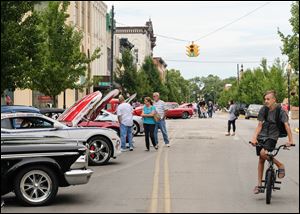
Eli Olmstead, 13, of Fostoria rides his bike on Main Street and checks out a classic car show.
Starting in the 1990s, the city’s factories closed their doors, one by one. In turn, residents who once had stable union jobs in town had to travel farther afield to find work, a trade-off that some say nullifies Fostoria’s low cost of living — the median value of an owner-occupied home is $62,900, compared to $131,900 in Ohio as a whole.
The timeworn trope exists for a reason: When the jobs go, everything else follows.
A walk down Main Street these days reveals remnants of a bygone era — a letter missing on the sign for a stately former opera hall, elegant windows devoid of display, wide streets shrouded in a perpetual quiet calm.
Mr. Kaminsky’s business, which just celebrated its 70th year, is right in the heart of downtown. After a 2008 fire burned their original store down, the Kaminskys could have gone anywhere. But, Mr. Kaminsky said, they chose to stay on Main Street because they wanted to be in Fostoria. They just love the town.
“We’ve always gotten a bad rep, but it’s a good community here,” he said.
Still, he admitted, without a loyal customer base, there’s no way they could get by. The town has lost so much industry, and without that revenue it’s hard for local businesses to stay afloat. Not even Fostoria’s Goodwill store could stay in business. It closed earlier this year.
“There’s not a lot to keep our kids here,” Mr. Kaminsky said.
Juliana Sanchez, 20, agrees. A stylist at the Beach House, a salon on Main Street, Ms. Sanchez said she’s conflicted. She was born and raised in Fostoria and is fond of the town, but she doesn’t see herself staying.
“I would love to be here if I could,” she said. “But there’s nothing here.”
City in the red
After several decades of steep decline, Fostoria received a crowning blow in late May, 2016, when State Auditor Dave Yost placed the city in a state of fiscal emergency. At the time, Mr. Yost told The Blade that loss of industry and the subsequent drop in income tax collections were to blame for Fostoria’s financial woes.
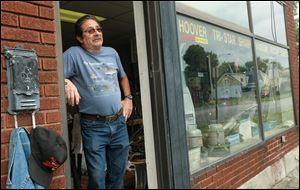
Mike Kauffman inside the Hoover repair business in Fostoria.
A month later, Mr. Trump stood onstage at the Republican National Convention in Cleveland and proclaimed, “My message is that things have to change — and they have to change right now.”
It’s easy to imagine how that sentiment resonated in Fostoria.
A look at 2016 election results by precincts reveals that Fostoria was more evenly split than any of the areas surrounding it. Five precincts went for Mr. Trump and three for Hillary Clinton. In one precinct, each candidate won exactly 46 percent of the vote.
Still, 2016 stands apart from other recent elections in town. Examine any given precinct and you’ll see why.
In 2008, Barack Obama received almost 60 percent of the vote in Precinct 1-A. Located in Seneca County, 1-A includes the city’s northernmost point. It’s shaped something like a beckoning finger. In 2012, 59 percent opted for Mr. Obama again and 38 percent for Mitt Romney. And in 2016, Mr. Trump won 50 percent of Precinct 1-A’s votes, while Ms. Clinton trailed behind with 43.
John Thomas, 61, owner of South Side Auto Services, voted for Mr. Obama in both 2008 and 2012. But in 2016, he cast his vote for Mr. Trump. As he saw it, the city never recovered from the 2008 financial crisis. Plus, he was sick of politicians and gentlemen, attracted to the idea of a ruthless businessman in the Oval Office.
“I wanted something different and I thought maybe he’d do something different,” Mr. Thomas said. With a laugh, he added, “Well, he is different!”
Even those who opposed Mr. Trump in his run for president can agree on that. Phyllis Cavey, 60, didn’t vote for him in 2016 and vows not to vote for him in 2020. She’s troubled by his zero tolerance policy and thinks his behavior may have negative ramifications for the country.
But, she said, “I like the way he talks, like he’s not going to take nobody’s crap.”
The law of averages
Mrs. Cavey has lived in and around Fostoria for most of her life. A few times, she and her husband moved elsewhere — they tried Oklahoma and Virginia — but somehow, she said, “We always seem to come back.”
For many, the town has a powerful hold. Despite Fostoria’s pitfalls, residents praised its community and fighting spirit and still see a place with potential. One supporter is Steve Kauffman. In the eight years since he moved to Fostoria, he has become one of its most enthusiastic advocates and proudest spokesmen.
Mr. Kauffman, president of Fostoria’s city council, loves his adopted town. Though he’s quick to acknowledge that Fostoria has seen better days, he believes staunchly that it’s on the cusp of a comeback. The day he spoke with The Blade, he wore a T-shirt that read “Fostoria vs. the World.”
“There’s a great underdog spirit here,” he said.
Recently, he and his fellow public officials received affirming news.
In July, the director of finance for the city announced that Fostoria’s general funds are finally back in the black. It was, Mr. Kauffman said, the most exciting moment of his tenure thus far. But he wasn’t entirely surprised.
“If you think about the law of averages, it was bound to happen eventually,” Mr. Kauffman said. “You can only lose for so long.”
Others working for the city are similarly optimistic. In recent years, “We’ve seen a number of businesses that either already have gone through expansions or are seriously considering expansions, and that goes across the board from small to large,” said Sarah Stephens-Krupp, director of the Chamber of Commerce.
She pointed out that every year for the last three, a new factory has also come to town. NOX US arrived in 2016, and Treves in 2017. And in February, Roppe Holding Co., purchased the former Autolite plant to make room for expansion.
“There’s a lot of positive momentum,” Mr. Kauffman said. “People just need to understand that these things take time.”
Day to day
Chris Mathias is excited by the turning tides. To his way of thinking, it’s all thanks to President Trump. Mr. Mathias worked at Autolite for 26 years, and was president of the union during the closure of the plant. Now, he’s one of several former Autolite employees working at Treves.
“It feels like we’re in a different time now where things are picking up a lot,” he said.
He loves Mr. Trump’s job-driven policies, and feels confident that under his leadership the country will “get back to [its] manufacturing dominance.” He voted for the Republican ticket in 2016 and can tell you already that Mr. Trump has his vote in 2020.
“They always said, you never got a job from a poor man,” he laughed.
Mike Kauffman, too, has no doubt that President Trump is saving the country.
“When you shake hard and see what’s coming out the bottom, he’s getting everything!” he said.
Mr. Kauffman, 70, worked at Atlas Crankshaft and later South Side Auto Services. As he ages, he said, he’s happy knowing he will die in a democracy. It makes him angry when people say that national politics don’t have any bearing on life in a place like Fostoria.
“Somewhere along the line, everything that comes out of Washington is gonna affect you,” he said.
One way the 2016 election has affected Fostoria already is evident in the everyday.
“If you go into a bar, you don’t bring up politics,” Mr. Kauffman said. Before Trump’s election, “you used to be able to.”
Some business owners in town said they worried about losing customers if they disclosed their politics. One said he already had.
For the most part, though, many said they don’t think or talk about politics too much. Mrs. Courtney makes sure to vote in elections, but, in between, she confessed, “I don’t pay much attention to politics.” She doesn’t know yet if she’ll vote for Mr. Trump again in 2020.
Where Washington is concerned, her wishes are simple.
“Don’t forget about us regular folks, the blue collar people that are just trying to make it happen every day,” she said. “We’re not millionaires, but we still want to make a good living and have a good life.”
Day-to-day, she finds it’s best to stay positive. And, despite everything the last year has thrown at her, there’s still plenty to be happy about. She has two healthy children, a good husband, a comfortable home. And she loves where she lives. She’s here for life.
“I love our fields and our country,” she said, looking out as the sun began to set against an endless Ohio sky. “It’s beautiful around here. I love it, I do. I’ll never move.”
Contact Eve Sneider at esneider@theblade.com or 419-724-6171.